Susan Tixier is a 59-year-old grandmother who lives in a trailer in Escalante, Utah, pretending to manage the Great Old Broads for Wilderness, “unmanageable by any earthly force though they are.” She sits on the boards of several other environmental groups in the West.
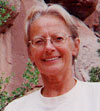
Monday, 22 Jan 2001
ESCALANTE, Utah
But yield who will to their separation,
My object in living is to unite
My avocation and my vocation
As my two eyes make one in sight.
Only where love and need are one,
And the work is play for mortal stakes,
Is the deed ever really done
For Heaven and the future’s sakes.
— Robert Frost, “Two Tramps in Mud Time”
found in Deep Play, by Diane Ackerman
“Going to work,” for me, is raising myself up on my elbows to watch the sun’s rays hit 50-mile Mountain, the Kaiparowits Plateau, the heart of the Grand Staircase-Escalante National Monument. This time of year with the snow clinging to it, the long, straight-east-facing cliff reflects pink gold; during the summer, when the Earth has shifted some on her axis, the plateau looks butter yellow at first light, uninterrupted as it peeks over the eastern horizon. Yawn. Coffee. Outside for a minute. Bow to the four directions. Welcome the day. And hit the desk at the other end of the trailer.
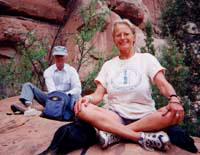
Me, hiking with another Great Old Broad, Fred Goodsell, in a redrock canyon near Moab in southern Utah.
Photo: Ray Bloxham.
Today’s business begins with the all-important staff call with Mary and Erin. Each of us works at home, or wherever she wants. It saves money (no overhead) and wear n’ tear on the staff, but it does mean we have many email and telephone conferences. Today we have to confirm final arrangements for Steve Allen’s series of slide shows in California and set arrangements for his shows in New Mexico, all coming up in February. Steve, a member of the Broads’ Board of Directors, is a pioneer in the art of canyoneering and has spent the last 30 years covering more vertical miles than most of us will walk horizontally! He’s seen, and photographed, the inside of canyons no one else has. He said, “I’m yours. I’ll do the shows on behalf of the Broads. All you have to do is make the arrangements.” Yeah, right!
So, between 11 and 20 Feb., Steve’s scheduled to have nine shows in the Bay area — at Patagonia, in Mendocino, at Golden Gate Park, Lodi, Stockton, and the Sierra Club, plus a couple of fund-raisers. Invitations are going out this week. Cards to members are already in the mail. Press packets have to go out. We have to make some posters to send to volunteers (God bless ’em!). Who’s going to oversee that?
At the end of February, Steve’s doing shows in New Mexico. We have the dates and the places; who’s going to get the list of names, print the cards, send the invitations? Yargh! So much to do yet.
Second item. Newsletter. Broadsides is scheduled to go out mid-February. Erin, did you get my piece: “Gale Norton — Great Old Broad for Wilderness NOT”? Do we have the pictures we took of the Broadwalk across Nevada in September?

Great Old Broads’ Broom Brigade meets the Shovel Brigade in Jarbidge, Nev.
Photo: Great Old Broads.
Have you covered the Jeep Safari over Easter weekend? We need as many Broads as we can get, dressed in black, to place black crosses in the lands that the hundreds of ATVs rip up during that foul week. Apparently, the event can’t be stopped or even much controlled, so all we can do is mourn. Do we have those pictures from last year’s event, those pathetic pictures showing the Broads trying to “sweep up” after these guys?
Do you have the information about the Broadwalk in D.C. in April? Again, I’d like an all-points bulletin to go out to all our Broads across the country. Three days “hiking the hill” to visit with our congressional delegation and to visit (do you think she’d let us in the building?!) Gale Norton, U.S. Secretary of the Interior, 25-27 Apr.
How ’bout the Camping in Cowpoop in early May? I think we have some pictures of the mess we found when we went out this fall. After all the snow in the Grand Staircase-Escalante National Monument and no cows, maybe some of those little springs have recovered. This is a hard sell — how do we get Broads to want to go out and camp in a smelly, messy, public lands wonderland for cows, take pictures, and then write about it?! I’ll have to write something to tell the readers just how much fun we had.
Thanks you all. I’ve gotta go raise some money! I’ll talk with you in a few days.
Lunchtime. I take a long run down a snowy dirt road on “the desert” between 50-Mile and Escalante canyons to put my thoughts in order about what the Broads are and what we do so I can convince a foundation or two about our fund-worthiness. (This is work, don’t you know!)
Just tell it like it is: The Broads honor these public lands because they are (mostly) wild and free from human impact. The Broads believe this country should stay that way — without ATVs, without cows, without any use that will impact the natural course of the land’s slow evolution. As I stand, huffing my old lungs full of cold, really fresh (and desperately needed) air, I listen to the snow sloughing off the trees, watch the ravens play; I can almost feel the grasses, the cacti, the P-J drinking up the snow-melt, under the crust, now sequined with fish-scale crystals from the warm sun and cold wind. Damn! This is. Simply is. Natural. All this takes place naturally and should not be interfered with by me or anyone else. How can I convince those dear people in their offices, bent over their paperwork, that this precious heritage is as irreplaceable as any part of America, what little there is left of these wild lands, and that the Broads can help save it?! Hmmm.
Tuesday, 23 Jan 2001
ESCALANTE, Utah
Time and trouble will tame an advanced young woman, but an advanced old woman is uncontrollable by any earthly force.
— Dorothy L. Sayers
Did I mention that, while I don’t have to travel far on a daily basis to get to work, I do put many hours on the road to attend any meeting? First job today is to get satellite information about this week’s weather. I have to travel to Salt Lake City on Friday for a SLC CHIX (Slick Chicks) gathering. How do I plan my week to travel either Thursday or Friday? What work can I do “on the road” if I should have to leave on Thursday?
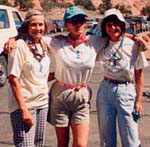
Want to see Shirley MacLaine in one of these T-shirts?
Photo: Great Old Broads.
There is no such thing as a “typical” work day here! Second chore? Figure out how in the world I can contact Shirley MacLaine and/or Carrie Fisher. I understand they’re producing a made-for-TV movie, These Old Broads. Harrumph. We’ve been using “Old Broads” since our inception and registration in 1989. I wonder if there’s a trade-name conflict possibility?! I wonder if they’d like to apologize in public. Or, I wonder if any of the “all-diva” cast is truly a Great Old Broad. I wonder if we can get them to show up in our very attractive T-shirts?
When the Broads organization was begun, it was in respo
nse to an anti-wilderness argument made by a man (who should have known better) that the “elderly” do not want federally designated and legally protected wilderness areas because we cannot access them without roads. Several of us took umbrage and decided the honorable senator from Utah, as well as others in Congress, should hear from some Great Old Broads for Wilderness about how we felt about roads in wild places. We started the organization without any thought to its becoming a nationally known, professionally staffed organization with about 3,000 members. And the rest is the history that I must relate to foundations today.
The relatively small budget (less then $250,000 for a national organization!) is supported in large part by the membership. The programs we seek to fund fulfill the organization’s mission statement: “The Great Old Broads for Wilderness is a nonprofit, public interest, public lands organization dedicated to the growth and protection of wilderness using the voice, the wisdom, and activism — and humor — of elders.”
Wilderness designation and protection for America’s wild public lands is our first priority. Broads operate as an essential and unique part of the various state coalitions that are doing inventories of our public lands for wilderness qualities. Sooner or later, citizens’ wilderness proposals are developed. The Broads hold at least one Broadwalk across some of the lands to be inventoried. Last year we were in Nevada; this year we’ll be in New Mexico.
Today, I write the first draft of an article about the Upper Calf Creek Wilderness Study Area for the Southern Utah Wilderness Alliance newsletter:
One of the most damaging practices on public lands is the overgrazing by livestock. The Great Old Broads for Wilderness have adopted the Escalante Canyons where we believe no grazing ought to occur, and are endeavoring to take the cows off any other areas where grazing adversely impacts public lands. While the Broads are not anti-grazing, we are most definitely opposed to its taking place in areas where the plodding, fat-hooved, eating (and pooping) machines tromp delicate and biologically important soils, graze every blade of graze, and destroy the few (obviously essential to wildlife) riparian areas and springs. If you had a pet cow you loved, you would not turn it out on the desert south of town here, for instance.
But the John Wayne myth of the West is dying an unseemly death in southern Utah. There is not money to be made from cattle grazing, but it’s a habit of life for some of the older folks here. Many areas in the West where overgrazing is devastating public land are the most beautiful in our country, so it’s easy to understand why people might want to try to stay and build a life from our public lands. It is not a tough call, however. Short-term delight for a very few is not worth forever destroying the unique biologic systems that are the warp of America’s Western heritage.
Today, I gather information about the Sierra Club’s position on grazing on public lands, feeling responsible not only as a Broad, but as a Utah Sierra Club Excom member and national council delegate. Hit the email and telephone lines. If Escalante had an electrical outage, the U.S. Post Office would see a burdensome increase in Broads traffic.
After a conference call of the board of directors of the Ecological Consultants for the Public Interest, a public interest legal/scientific group working on environmental toxic issues, I spend several hours phone time in New Mexico.
Steve Allen’s shows in New Mexico must still be coordinated. The New Mexico Wilderness Alliance, of which the Broads is a member, will be the beneficiary of the Broads’ largesse (no jokes!) in 2001, as we Broads Broadwalk across some proposed wilderness (probably) in southern New Mexico. The tit for tat (no jokes!) will be their assistance with the slide shows.
Call Edward Sullivan for lists and possible locations for the Broadwalk. Begin to order maps; make camping reservations somewhere around Silver City and the Gila Wilderness. Also begin to make inquiries about Chix in the Stix II.
But, back to fund-raising. Chix in the Stix I, the gathering of Broads of all ages was a huge success. Held in southern Arizona in December 1999, the meeting allowed the Broads to teach and learn about Broadness and become familiar with the feminine ways (also employed by the best of men) best suited to wilderness advocacy. Chix in the Stix II will gather together in New Mexico in December 2001. I wonder who would like to contribute to bring the 50 women from across the country to southern New Mexico?
Wednesday, 24 Jan 2001
ESCALANTE, Utah
We have met the enemy, and he is us, too!
— (paraphrasing POGO)
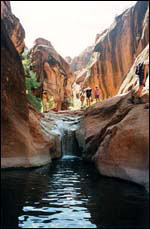
Broads on a Broadwalk.
Photo: Great Old Broads.
Today’s tasks are the stuff that EDs are made of, I believe, and are, therefore, the most difficult — and satisfying — of all I do. I have a conference call in a few minutes with members of the Broads’ board of directors to discuss our role in the wilderness campaign in the Bush/Norton administration. It’s one thing to be a “grandmotherly” support team; it’s quite another to be a “Grandma Swat Team.” I think Secretary Norton will not be impressed with the Broads’ philosophy of “protect, don’t use” public lands. On the other hand, I’m not sure the membership wants to wear hobnailed boots and march on D.C.!
After the call, I will spend the rest of the day dressing up the following essay for publication in the Southern Utah Wilderness Alliance newsletter, where it will appear in far better form thanks to their excellent editor, Diane Kelly. This piece, on an area of wildness in southern Utah, will be a “Wilderness Spotlight” in the Spring 2001 publication.
Upper Calf Creek Falls — Revisited Too Often?
Imagine a very large lemon meringue pie at your picnic under the clearest blue skies ever. See that teeny, little bug crawling across the gently puffy, whitish peaks? Wee grains of sand cling to the sides of the broken waves and riverlings of shiny liquid can barely be seen deep down in the cracking confection. Fall deep into a full-tummy-too-much-wine stupor, become that teensy bug, and come with me — to Upper Calf Creek Falls, a Wilderness Study Area (WSA) in the Grand Staircase-Escalante National Monument.
“Confection” is a word that easily comes to mind when standing on the edge of the drop-off into the Upper Calf Creek WSA. And it is hardly necessary to have had too much wine to imagine that you are about to descend into meringue. In fact, you will be friction-walking down Navajo sandstone slickrock, avoiding the scattering of black, round volcanics, the “wee grains of sand” in our dream.
Upper Calf Creek Falls is off Highway 12 in southern Utah between Escalante and Boulder. There is a trailhead sign, now, and the Bureau of Land Management has improved the parking area. (I recall digging our car out of deep, fine sand after we had climbed out of the canyon 15 years ago. I promise you, it was better to dig and to have the adventure than to have the walk-in-the-park experience of today.)
Picking my way down the considerable slope almost 15 years ago, I took care to find purchase on the slickrock, free from volcanic gravel or small rocks. Today, there is clear passage. Many, too many, hands and feet have made the descent “safe” — depriving us of the breathless sense of wild approach.
The landscape is mostly rock, beautiful, sculpted, frozen-in-time sand dunes. Here and there are very tall ponderosa, very short pinyon, a collection of cacti, humps of blue grama grass, and stands of oak. In the
spring and early summer, there are flowers, not in opulence, but a single flower on a slender green stem, simply highlighting the backdrop of pink-tinged white rock.
You can hear the water before you reach the bottom of the slope, echoing off the high walls of what is no longer “slope,” but is in fact a canyon. Today, the obvious trail splits, one fork going up above the falls and the other dropping into the canyon. Fifteen years ago, there were no trails. You might have missed the secret pools above the falls, or even fallen to your death into cheery, bubbling Calf Creek.
Fifteen years ago, the descent was into an innocent verdurous paradise. The sound of water falling 126 feet, the feel of water-mist all ’round closed the door on the white-hot rock. Protective, very healthy branches of unexpected large trees, ferns, green things (!) grabbed me as I crept toward the sound.
Then, there it was. The most turquoise and green and blue pool. Swallows diving through the mist. Little white marigolds of some kind bobbing on the swell at the edge of the pool, moving as the water free-fell from above. Watercress begging to be sandwiched. This was surely the place Zane Grey wrote about in Riders of the Purple Sage, where our hero and heroine could live their lives, never to be found, with all one would ever need to exist right here.
All this still exists. Barely. The pool is generally cloudy now, filled with sand from the people who romp in the pool, splashing and throwing mud, or play in the (not very) surprise pools above the falls. Where there are still fish, there are also pieces of cheese and cold cuts people have left to lure them from under the collapsing banks. Toilet paper among the ferns. Footprints on the ever-increasing sandbars.
The trip down takes less than an hour. Straight down, no problem. Jump in, but keep your clothes on. There are bound to be at least a dozen others with the same thing in mind. Down a quick beer. Hike back out. All before lunch.
This is a dilemma. This area is protected. It’s a Wilderness Study Area. And it is being trashed. Not by cows. Not by ATVs. Not by logging, or mining. But by us.
There must come a time when we choose to honor and revere these wild places. Loving them enough to leave them alone — to be, to exist, simply because they are there.
What do you think? Will it be accepted?
Wednesday, 24 Jan 2001
ESCALANTE, Utah
In the next century
or the one beyond that
they say,
are valleys, pastures.
We can meet there in peace
if we make it.
To climb these coming crests
one word to you, to
you and your children:
stay together
learn the flowers
go light.
— Gary Snyder
Today I’m “going light.” It’s a UTW day here — under the weather. It’s drizzling snow and cold. I think I feel a bit of a bug tickling around in this old body and, because I have a frantic travel schedule all weekend, I’m not going to give it a chance to survive — referring, of course, to the bug, not the body. I’m not taking the bug, or the body, outside today. Not even to run.
So, after a morning of phone and email communication, writing a dozen letters in response to inquiries, and sending information to supporters, I have taken some time to catch up on my reading.
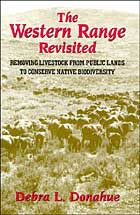
Professor Debra Donahue’s book, The Western Range Revisited — Removing Livestock from Public Lands to Conserve Native Biodiversity is, obviously, about grazing. Yesterday, the nomination of Gale Norton as Secretary of Interior was successfully passed out of the Senate committee. When confirmed by the whole Senate, she will be in control of the largest federal land management agency and a large chunk of this country’s wildlife habitat. It will be interesting to see whom she chooses to direct the Bureau of Land Management — for it will be up to these individuals to either manage the lands for all of us, for all time, or for only a selfish few. “Grazing reform” could be the second issue Ms. Norton will face, after she tries to drill in the Arctic National Wildlife Refuge. Who, you might ask, cares?
From the Broads’ perspective, it’s about the land. Livestock graze over 70 percent of our western United States, including the delicate riparian areas and springs on which the wildlife and plant life depend. Tortoises are stomped and their habitat destroyed. There has been a sad reduction of native biological diversity on the arid western rangelands. Camping in cow poop is not for sissies.
Western Senate members are a powerful political body. One-third of the total Senate membership is from the western United States, an area that is relatively unpopulated — by people. Ranchers in the West were, and many still are, the elite in the West, like the plantation owners in the old South. Handsome, strong, fearless — and wealthy. Many of the western Senators were ranchers, came from ranchers, and/or are supported by ranchers. There is the myth thing: cows and cowpokes. I have seen people hop out of their cars to take pictures of a cow! Presumably, these folks believe they’re recording a wildlife encounter, or just feel bonded to John Wayne. Whatever the reasons, less than 20,000 permittees yield tremendous power over those in D.C. who manage lands that belong to all Americans, today’s and tomorrow’s.
Debra’s book provides the historic, legal, economic, biological, and sociopolitical documentation for taking cows off public lands (for which the Wyoming legislature was going to refuse to fund the Wyoming School of Law, where she teaches). Mute, tragic testimony is provided by our public lands.
“Learn the flowers.”

Birth of the Chaordic Age, by Dee Hock, is not exactly Management Principles 101. I do not apologize, however, for reading this fabulous and inspiring book on company time. It is reported that Dee Hock holds up a Visa card when he lectures and asks: Who knows what this is? Everyone does. He then asks: Who can tell me who the CEO is? Where the headquarters are? What the stock is worth? No one answers.
Hock gently, beautifully points out that many of our organizations are structured on 17th-century concepts and, therefore, are not adequate for dealing with today’s much different world. He suggests that the “organization of the future will be the embodiment of community based on shared purpose calling to the higher aspirations of people.” I believe the environmental organizations would do well in hearkening to his words.
“Chaordic” is a word that describes the fundamental organizing principles of evolution and nature. A number of institutions are responding to these principles, and I believe environmental nonprofits ought to be among the first. Like nature, the Broads try to be self-governing, fast on our feet (organizationally speaking, of course), able to organize and reorganize, principled, and unique in our role and habitat. A mixture of chaos and order: That’s us.
“Stay together.”
And finally, for good reading, I picked up Cod, a Biography of the Fish That Changed the World, by Mark Kurlansky. I love this book. History based on a fish. Would that history were taught this way, maybe we could have revered and protected this bottom-feeding, oh-so-esse
ntial connection in our “chaordic” lives. When will we ever learn? A simple fish that supported the evolution of our world, and we have destroyed it.
“Go light.”
Friday, 26 Jan 2001
ESCALANTE, Utah
“What would you say that the main theme
of your poetry is?”
“To put it as simply as possible.
I say it this way: to recognize
the relationships I share with everything.”
I would like to know well the path
from just east of Black Mountain
to the gray outcropping of Roof Butte
without having to worry
about the shortest way possible.
— Simon J. Ortiz, “Woven Stone”
Simon Ortiz is part of my morning ritual. His words help me to hold for a moment the knowledge of where we all came from and how we’re all connected. Mr. Ortiz has recorded time in his bones, absorbed confusion and pain, and passed on to us the air of the ancients. As I start off on the road this morning, in the black and cold, I wish that breath could touch everyone.
Today’s journal entry is, thankfully, short. I am on the road for six hours to Salt Lake City from Escalante for a gathering tonight of the SLC Broads, the Slick Chicks.
The Great Old Broads for Wilderness is a female organization. Some of the attributes of femaleness have been laughed at, decried, and denied for as long as I can remember, and I am very old! Gossip, for instance. Women talk. And the best of men, who have a good touch of femaleness, also talk. Talking is a good thing. We encourage it.
Groups of Broads just sort of naturally come together to talk, which is how the organization has grown — by word of mouth — to almost 3,000 recognized members. (There are doubtless hundreds of thousands of Broads whom we have not heard from yet, but we will.) Groups of Broads across the country are coming together naturally. Each group is different; there are no rules. There are no dues.
The get-together tonight is with a group that started after a bunch of us went to Jarbidge, Nev., to brace up the Shovel Brigade last July. (Rumor had it 10,000 angry men with shovels were going to rip up an old roadbed — just because it was the manly thing to do — and destroy the habitat of the endangered bull trout. It turned out there were 300 of them and they dug a 90-foot road. Yawn.) Many in that group of Broads were from Salt Lake City. And here we are gathering together, as we have since last fall.
We have met for beers and for dinner. While Broads love beer and dinner, a “cell” of Broads cannot exist for long without creating action energy. The Broads called for purpose, so tonight’s gathering is to talk about Utah Broads doing some archival research to determine what the Grand Staircase-Escalante National Monument lands looked like B.C. — before cows.
One of the difficulties in bringing lawsuits alleging grazing damage is that there is no “before” picture to show the court. People who come here for the first time believe that this is how the land has always looked. Cows have been on the land here for over 100 years, before there were convenient cameras for taking the casual snapshot of your ol’ backyard desert. We are hoping that written materials, photographs, and drawings exist that will refer to the springs in the desert, or the grasses, or the wildlife that existed there — B.C.
We have some Broads who know their way around the various library resources at the universities and other places to guide us. If nothing else, it will educate us about the people who settled southern Utah and, because many of their great-grandchildren are still residents here, something about the folks who now own the cows.
Also on the nonyagenda is plotting and scheming in preparation for our appearance at the Jeep Safari in April in Moab.
And, after enough of the homemade wine, we’ll discuss Camping in Cow Poop in May. (Broads are game as hell, but they are not stupid!)
The sun’s coming up behind me, reflecting off the obscenely pink cliffs of Bryce Canyon. There is no way to convey the breathtaking scene. I have to stop and step out to welcome the sun — and because I’ve had lots of coffee. It’s cold and crisp. Pink and gold. The sky in the west shimmers pink, blue, and yellow changes, like a Barbie doll aurora borealis. Please believe me, this is true. A bald eagle just flew off its breakfast up into a ponderosa, away from me so I can see the spread of the white tail feathers as he lands. I am the luckiest, the richest, and most grateful SOB. What a life.
Namaste.
That dream
shall have a name
after all,
and it will not be vengeful
but wealthy with love
and compassion
and knowledge.
And it will rise
in this heart
which is our America.
— Simon Ortiz, from “Sand Creek”


